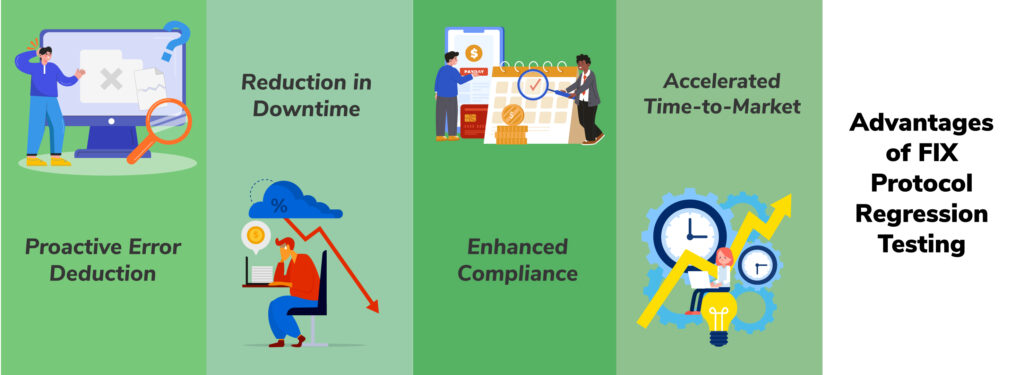In this fast-paced world of financial markets, milliseconds can make huge difference between profit and loss. Ensuring reliability and accuracy of trading systems is becoming paramount. Here FIX Protocol Regression Testing will be the best part to pitch in.
FIX Protocol Regression Testing not only validates the functionality of trading systems but also plays a major role in mitigating trading risks.
This article delves you into how FIX Protocol Regression Testing mitigates trading risks and best practices of how companies deploy it to minimize technical disruptions and business-level risks.
Understanding the FIX Protocol
Financial Information Exchange (FIX) protocol is the open standard messaging interface which is designed to exchange trade-related messages in the financial markets. FIX accommodates
- Order management
- Trade instructions
- Automation
- Report Execution
- Market data
Every message in FIX plays a crucial role in trading at the same time any failure while delivering the message can disrupt the market and lead to disastrous effects.
That is where FIX Protocol Regression Testing is used to minimize trading risks by ensuring each FIX message functions promptly.
What is Regression Testing?
Regression testing is a process of re-executing finished tests and validate the new code developed is not affecting the existing features. In trading even a single bug can derail millions of dollars in trades.
Now layer the FIX protocol specific logic to the testing process, and there you have a highly specialized safety net which is specifically tuned for critical requirements of trading systems.
Key Elements of FIX Protocol Regression Testing
To understand how FIX Protocol Regression Testing reduces trading risks, let’s have a look with its components,
- Message Validation
Ensures all FIX messages follow protocol’s specifications and match expected formats. - Order Flow Simulation
Simulates trading scenarios and test order types like day, market, limit, IOC, FOK, GTC, iceberg and stop orders. - Negative Testing
Deliberately passing malformed or error data to observe how the system handles the data. - Latency Testing
Measures the response time of FIX messages to ensure they meet high-frequency trading requirements.
10 Ways FIX Protocol Regression Testing Reduces Trading Risks
- Avoids Production Outages
Fixes bugs before they reach production environments. - Ensures Multi-Asset Workflows
Makes sure equities, options and FIX messages are processed appropriately. - Minimizes Human Error
Automated test cases eliminate the chance of human supervision risk. - Identifies Performance Bottlenecks
Identifies message delays that may affect order execution speed. - Enhances Client Confidence
Supports with client demand and execute perfectly. - Compliant with Regulatory Requisites
Ensuring all trade messages align with changing regulatory compliance. - Facilitates Fast Deployment
CI/CD pipelines function optimally when testing is embedded, enabling secure frequent releases. - Manages Third-Party Integrations
Regression testing ensures that modifications in external APIs or market data feed don’t disrupt internal systems. - Maintains Data Integrity
Avoids trade report mismatches and back-office processing. - Facilitates Disaster Recovery Testing
Ensures proper behaviour of systems during malfunction or backup environments.
Building a Regression Testing Framework
Are you desired to ensure how FIX Protocol Regression Testing reduces trading risks in your environment?
Here’s the starting point on building the framework,
- Define core workflows (buy/sell, cancel, amend, market data, etc.)
- Create test libraries per message type
- Use automation tools such as FIX simulators and test harnesses
- Integrate with CI/CD tools for continuous monitoring
- Update and check regularly as systems and regulations change
The more organized your testing environment the better FIX Protocol Regression Testing minimizes trading risks
Best Practices of FIX Protocol Regression Testing
Automate Test Processes: Install automated testing software to make the regression testing process streamlined, eliminate human errors and enhance test coverage.
Simulate Real-World Environments: Create test cases that stimulate trading environments to effectively evaluate the system’s performance and behavior.
Sustain Inclusive Test Suites: Create and maintain an inclusive suite of test cases that address all components of the trading system, such as order entry, execution, and settlement processes.
Periodic Update of Test Cases: Periodically update test cases to capture modifications in trading system as well as the changing regulatory environment.
Collaborate Across Teams: Ensure cooperation among development, test and operations teams to integrate all stakeholders and ensure always be on the same page and be aware of the testing process.
The Role of Data in Regression Testing
Data accuracy is the lifeblood of any test suite. Test data with poor quality creates false positives or negatives and render your testing to sound unreliable.
FIX Protocol Regression Testing Minimizes trading risks by employing actual or production data sets to replicate the real trading scenarios.
Here are the data-driven testing tips:
- Employ historical trade data for realistic simulations.
- Enforce edge cases such as trading halts, volatile markets or order floods.
- Anonymize client-sensitive information to meet privacy legislations.
Benefits gained by FIX Protocol Regression Testing

- Proactive Error Deduction
FIX regression testing enables teams to detect errors before they hit production. These services stimulate real-world environments and check message flows. - Reduction in Downtime
Reduce system downtime by verifying key workflows are in working in order and following code deployment or infrastructure updates. - Enhanced Compliance
Regulated financial markets require compliance with stringent global and local regulations. Eg., MiFID II, SEC requirements or exchange protocols. - Accelerated Time-to-Market
Automation speed release cycles by reducing manual test efforts, enabling trading firms to release faster in the market.
Real World Use Case: Global Bank Avoids Major Outage
One of the world’s leading investment banks was deploying an update to its equity execution Fix engine. With automated FIX Protocol Regression Testing, they found a sequencing bug that would result in thousands trade rejections.
Through this testing, the problem was identified and fixed pre-deployment. Lesson learned? FIX Protocol Regression Testing reduces trading risks not only in theory but in real-world use cases and in the high-stake environments.
Tools that facilitate FIX Protocol Regression Testing
To facilitate the argument that FIX Protocol Regression Testing reduces trading risks, numerous firms invest in sophisticated tools. One of the leading FIX Protocol testing tool is Phifix Test Suite
Key Features of the Phifix Test Suite
End-to-End Trading Workflow Support
Comprehensive business coverage of business scenarios throughout the entire lifecycle of pre-trade, trade and post-trade stages to support reliable functionality across the board.
FIX Message Analyzer
Built-in tools for decoding, validating and examining FIX messages to assist testers and developers in promptly locating errors and discrepancies in message structure or data.
Regression Testing Modules
Supports comprehensive functional and connectivity testing, enabling clients to stimulate high-load environments and confirm system behavior under different real-world conditions.
Session & System Variable Configuration
Facilitates the defining of default variables for both the user and connection levels, enhancing reusability and minimizing manual configuration on multiple test cases.
Custom Validation Framework
Enables users to specify custom validation rules at any level based on API or business needs providing high flexibility and control over testing logic.
Conclusion
PhiFIX equips the organization to perform FIX Protocol Regression Testing by using PhiFIX Test Suite, which actively manages system vulnerabilities, verifies message flows and simulates trading conditions. By reducing technical malfunctions and business risks, firms can deploy updates with confidence, sustain regulatory compliance and guarantee smooth trade execution.
It’s not just about preventing disruptions—it’s about enabling a safer, faster and more reliable trading experience in the evolving market.






